MARTE SALDAÑA – the cerebral Mighty Mite of Philippine
basketball
The Philippine Basketball Association (PBA) has produced a bevy of
top quality court generals in its 43 years of existence. Some, like Robert
Jaworski and Johnny Abarrientos, merited some consideration from NBA scouts.
Ricardo Brown himself was a third round (59th overall) draftee of
the Houston Rockets in the 1978 draft but the former Pepperdine star wasn’t
able to sign up with the team.
Coming up with a list of the top
point guards in the PBA always poses a nightmare for every writer to have a credible and generally-acceptable list. With an abundance of talents to
select from, the list normally extends beyond the maximum ten.
One under-the-radar PBA legend who
may not merit consideration, particularly among younger writers, but is
definitely acknowledged by those who have seen him play, is Marte Saldaña. The
late broadcaster and anchor, Pinggoy Pengson, gave Saldaña the moniker, “Mighty
Mite,” in reference to his ability to flex his muscles and dominate games
despite his lack of size and heft. A winner in every level of his playing
career, Saldaña is best known as the Rookie of the Year in 1982, besting
several other candidates that included Toyota stars Terry Saldaña, Ricky
Relosa, Tim Coloso, and Ed Cordero.
Early Life
Marte Divinagracia Saldaña was born
on February 23, 1959 to parents Bartolome of Leyte and Diana of Iloilo. He was
raised in Murphy, Cubao in Quezon City and studied at General Camp Emilio
Aguinaldo High School located inside Camp Aguinaldo, not surprising since his
father was a military man. It was also not uncommon that Marte wanted to join
the Philippine Military Academy (PMA) himself, having been exposed to the
strict regimen of his father. He transferred to Far Eastern University High
School in 1974 after being discovered by then MICAA standout Bert Dela Rosa
(later played for YCO/Tanduay in the PBA), enticing Saldaña to join Dennis
Roldan, Ed Corpuz and the rest of the Baby Tams. He eventually took up
BS-Management at FEU from 1975 to 1981.
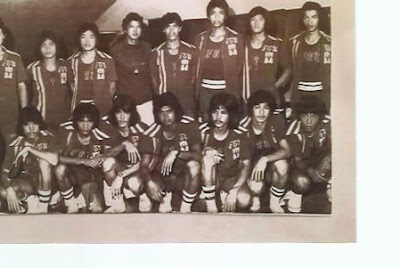 |
| The FEU Tamaraws 1976 |
Start of Something Big
The diminutive 5’9, 160 lb. Saldaña
rose to prominence at a young age of 16 when he was part of the FEU seniors
basketball team as a freshman. His teammates included the likes of Renato Lobo (http://sportingpage.blogspot.com/2018/03/renato-lobo-last-breed-of-pigeon.html), Anthony Dasalla, Roy Deles, Nic Bulaong, Ben Brillantes and Pablo Javier. He
was then a reliever at the point guard position, but in the Finals against the
eventual champions, the UE Red Warriors, led by the prolific Emerito Legaspi (http://sportingpage.blogspot.com/2012/03/emerito-legaspi-from-amateur-superstar.html), he sizzled with 19 points in a losing cause.
1976 turned out to be the breakout
year for the cerebral point guard. He was inserted by his head coach, Arturo
Valenzona, to the starting point guard position, playing alongside Danny
Manalastas, Armando Valencia, Lobo and Dasalla. From the getgo, the Tamaraws
stamped their class and became not just the champions of the UAAP 1976 season,
but also, the then prestigious Battle of the Champions tournament featuring the
top collegiate schools from other leagues. The Tamaraws upended the NCAA champion Ateneo
de Manila University Blue Eagles that featured Steve Watson, Joy Carpio, Padim
Israel, Fritz Gaston, Louie Rabat, Chito Narvasa, among others.
It was also in 1976 when Saldaña
finally started earning on his own, receiving P400 a month to play for the
Mohawk Brokerage under Valenzona in the Interclub. He later moved with
Valenzona to Solid Mills in the second conference to form a formidable team
made up of his FEU teammates Dasalla and Lobo, along with Benjie Chua, Butch
Beso, Conrado Pasco, Bernardo Caparas, Valencia and Rey Obias. True enough, the
Denim Makers stamped their class, demolishing the Abe King (http://sportingpage.blogspot.com/2011/10/abe-king-jr.html) and Emer Legaspi-led
Frigidaire in the finals for the crown.
Frigidaire though was able to exact
vengeance the year after, this time at the MICAA tournament, when the Silverio
franchise defeated Solid Mills in a close series of the 1977 first conference.
In the next conference, Saldaña teamed up with Lobo and Dasalla to give Solid
Mills its first MICAA title, defeating the YCO Painters in the finals. By then,
this triumvirate, along with their head coach, Valenzona, became fixtures in
various national teams.
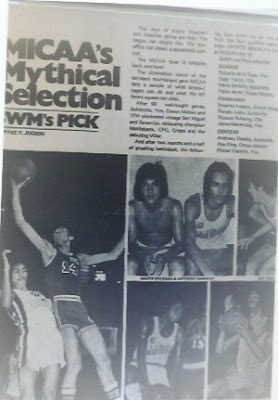 |
| Saldaña selected as MICAA Mythical 5 member by SWM |
National Team stint
Saldaña was part of the victorious 1978 RP Youth team that won the
crown in Manila, earning the right to represent Asia to the 1979 World Youth
Championships. He was also one of the driving force of the national team that
won the 1978 Pesta Sukan tournament. By the end of the year, Saldaña suited up
for the national team that played in the Bangkok Asian Games, wounding up 5th
overall.
He also led the RP Youth team in the 1979 World Youth Championships
held in Brazil, where he ended up being the team’s second-best scorer (behind Cristobal's 18.7 ppg) and the
tournament’s 8th best with 17.0 points per game. In their game
against the powerful Yugoslavian team, Saldaña and teammate Bay Cristobal kept
the team’s flickering hopes alive, even leading their European rivals at the
end of the first half, 53-48. In the end, the Slavs’ height and firepower proved
too much for the fighting Pinoys, eking out a slim 106-102 victory in what
could have been a major upset. Saldaña led all scorers with 31 points despite
being the smallest guy in the court, backstopped by Cristobal’s 27. Saldaña
similarly scattered an impressive 31 points against another mighty Euro team,
Italy, losing out 88-71. The Philippines ended up 10th overall (out of 12 teams) in the tournament
won by the United States in dominating fashion, winning by an average of 41.57
points against their rivals. Curiously, that US team was made up of future NBA
pros James Worthy, Eric “Sleepy” Floyd, Fat Lever, Scott Hastings and Sam
Perkins, a testament to the talent and skill level that participated in this
tournament.
He was later plucked by Coach Freddie Webb to lead the Philippine
charge in the 1979 Asian Basketball Confederation (ABC, now called FIBA-Asia) to
be held at Nagoya in Japan. Unfortunately, the team lost to their three main
rivals, China, Japan and South Korea and missed out in the medal podium. It was a
sorry loss against the Sokors in the elimination round, 118-107, making it
difficult for the Filipinos to contend for the crown as they had to face a
hostile crowd plus bad officiating from the Japanese on a cold December weather.
The Chinese eventually won the crown, beating the eventual runner-up hosts in
overtime, 70-68 and the Sokors on the last day, 94-88.
Moving to APCOR
When business tycoon Herminio T.
Disini became actively involved with amateur basketball through the HERDIS Group of
Companies, his business empire involved in oil exploration, mining, textile
manufacturing and flight chartering, it wasn’t long before he decided to put up
his own basketball team. He formed APCOR, his financing company, and named his
team the APCOR Financiers. Together with his right-hand guy, Nonoy Toledo,
Disini assembled a dominant team and his first step was to lure Valenzona.
When they succeeded in acquiring Valenzona as the head coach from Solid Mills, his old FEU and national team wards joined him. Saldaña
was perhaps Turing’s first choice as it was critical for him to get the star
guard to lead the team. Other big names followed suit: Cristobal, Pasco, Yoyoy
Villamin, Ramon Cruz, Padim Israel, Terry Saldaña, Gary Vargas, Zaldy Latoza, Rey
Lazaro (http://sportingpage.blogspot.com/2018/02/chancing-upon-pba-legend.html), Gerry Samlani, Alex Clariño, Alfredo Amador, the Guzman brothers – Joel
and Noel, Allan Meimban, Florante Dela Cruz, Rudy Garcia, Joselito Danggoy,
Romeo Martina and Rey Ramos. For Saldaña, he had no second thoughts of joining
a rookie team – while he was a reluctant superstar who didn’t see himself
playing in the pros, the APCOR offer was too lucrative to pass up on.
Backstopped by a huge budget, it was
almost inevitable for the Financiers to become champions. And true enough, in
their debut season of 1980, the Financiers started dominating all the amateur
tournaments at that time – the MICAA, the National Seniors and the Interclub. By
then, Disini was also engaged in a personal rivalry with another Marcos crony,
Eduardo “Danding” Cojuangco, Jr. Cojuangco was appointed as the project
director for basketball in the midyear of 1980, and immediately took steps to
strengthen amateur basketball. Being rivals with Disini, Cojuangco decided to
put up a pool of players made up of Americans (Steve Schall, Steve
Lingerfelter, Eddie Joe Chavez, Dennis Still, Bob Worthy, David Wear, Jeff
Moore), Fil-Americans (Ricardo Brown and Willie Pearson) and homegrown talents
culled from other MICAA teams like Frigidaire and YCO and collegiate schools to
be coached by Ron Jacobs (http://sportingpage.blogspot.com/2015/12/coach-ron-jacobs-learning-to-believe.html) from Loyola Marymount. Eventually, Cojuangco had
another set of top local players on his side – players like Ricky Relosa, Manny
Victorino, Frankie Lim, Itoy Esguerra, JB Yango, Bokyo Lauchengco, Ed Cordero,
Teddy Alfarero, John Copada, Elmer Reyes, Louie Brill, and the Pumaren brothers
– Derrick and Franz. There was a special tournament when Cojuangco’s American-led
NCC national team got to play against APCOR with the Cement Makers flexing its
muscle by routing the Financiers.
By this time, Saldaña suffered a
right knee injury that he needed to recuperate and couldn’t play. His loss was
a blow to the team’s chances as he was their best player as well as their
leader. He was also the one person capable of guarding Hector Calma, then
already being groomed by Jacobs to be his court extension. In 1979, Calma, who
led the Adamson Falcons to its only UAAP title in 1977, was only a backup point
guard to Saldaña at Solid Mills. Nevertheless, with Still, Moore and Brown
leading the Cement Makers, APCOR didn’t stand a chance. At that time, Disini
was also entertaining the possibility of bringing his entire APCOR team to the
PBA as a new franchise. It was bound to be the team of the future as APCOR was
able to beat the PBA champs, Crispa, in tune-up games, underscoring their
strength and vast potential.
Turning Pro
Disini eventually left the country
and was exiled in Austria after being involved in several cases including the controversial Dewey Dee caper of 1981.
APCOR disbanded and the players were dispersed, most of them turning pro midway
into the season. Villamin, Cruz, Cristobal and Israel joined the Crispa
Redmanizers, Lazaro and Latoza went to Tanduay, Samlani suited up for U/Tex, Clariño
went to Gilbey’s Gin, Vargas with Galleon Shippers, Joel Guzman to Galerie
Dominque and twin brother Noel to Great Taste. Saldaña joined the PBA in 1982
along with other rookies like Relosa, Cordero, namesake Terry, Lauchengco and Tim Coloso. Marte
went to the San Miguel Beermen under Coach Tommy Manotoc as he was convinced by
his former Solid Mills teammate and brother-in-law Obias to join him at SMB.
Marte went to the SMC office, then based in Makati, and met with Manotoc who tendered
him a 2-year contract right away.
 |
| Saldaña donning jersey #7 for the Beermen |
1982 turned out to be a good year
for Marte. Running second to Terry in the rookie of the year race (http://sportingpage.blogspot.com/2011/10/pba-rookies-during-early-years.html#more), Terry found
himself getting disqualified from the ROY race after being involved in a fracas against a South
Korean player in the 2nd conference – called the Asian
Invitationals. As such, Marte became the undisputed leader in the rookie stats board, and, strengthened with a championship, a runner-up finish and a 3rd
place finish for the Beermen, won the ROY award. He also was fortunate to play
in the Mello Yello All Star series held in Manila and Cebu where he suited up
for the North team coached by Robert Jaworski (http://sportingpage.blogspot.com/2011/10/robert-jaworski-sr.html). Arnie Tuadles (http://sportingpage.blogspot.com/2011/10/arnulfo-arnie-tuadles-jr.html), who scored 50 points in one of those two games, was adjudged All Star MVP. It was a phenomenal recognition
for the young Saldaña to be named an All-Star on his rookie year.
PBA Success
Marte made sure he won’t be
suffering from the sophomore jinx syndrome, a situation when players on their second
year would suffer a drop in their game or experience an injury. Fortunately, he
continued his successful foray in the PBA for the Beermen.
With Crispa dominant in the 1983
season, Saldaña continued to earn the respect of his teammates and opponents
with his cerebral court generalship. One of the more memorable games for that
year was when the Beermen snapped Crispa’s 21-game winning streak in the second
conference. That run remains a record to date. With Dasalla making Crispa super
import Billy Ray Bates lose his temper, import Donnie Ray Koonce scoring at
will, Lim Eng Beng (http://sportingpage.blogspot.com/2016/01/lim-eng-beng-1941-2015.html) playing the veteran role, and Saldaña quarterbacking, the Beermen pulled off a 110-99 shocker on
that fateful June 23 playdate. Koonce topscored for the Beermen with 32, with
Marte tallying 18 points, 4 boards and 5 dimes in a solid all-around effort.
Manotoc, who left SMB for Crispa
prior to the start of the 1983 season, is credited by Saldaña to have given him
the trust and confidence from a PBA coach. He distinctly remembered Manotoc’s
advice to study his opponent’s moves, a strategy that Saldaña took to heart and
continued applying until the final days of his career. But with Manotoc moving
to Crispa, Saldaña had to work with a new coach, Nat Canson, erstwhile head
coach of Frigidaire in the MICAA (http://sportingpage.blogspot.com/2011/10/micaa.html).
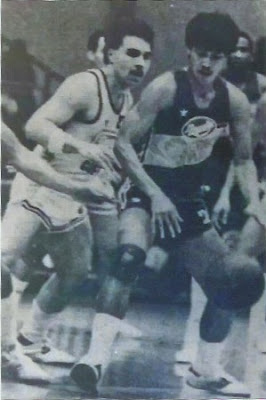 |
| The Quick Brown Fox vs. The Mighty Mite |
It was under Canson that Saldaña intimated
having played the best years of his life. From 1983 to 1985, Saldaña flourished
under Canson’s tutelage and prodding and where he emerged as one of the top
point guards in the league. In 1985, partnering with Norman Black and forming a
potent Mutt and Jeff tandem, the two led the Magnolia Ice Cream Makers to the
Finals of the Open Conference. They lost to the mighty Great Taste Coffeemakers
of Joe Binion and Ricardo Brown but Saldaña acquitted himself well in this
tournament, proving to all that he can stand toe to toe versus the Quick Brown
Fox, the eventual MVP for the year.
Turning Milkman
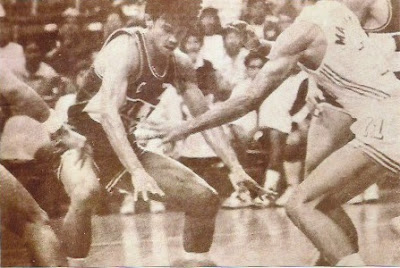 |
| As lead point guard of Hills Bros fighting for the loose ball vs. Shell's Totoy Marquez |
 |
| Saldaña defending Presto import and NBA veteran Tony White |
When the People Power Revolution broke
out on February, 1986, San Miguel decided to take a two-conference leave of
absence from the PBA. Saldaña, along with SMB teammates Noli Banate and Rudy
Distrito, were taken in by new team Alaska. Marte struggled a bit in the onset
as his first two coaches, Tony Vasquez and Cesar Jota, weren’t able to
maximize his skill set as much as he wanted. Fortunately, in the season after,
Alaska hired Canson as head coach, reviving hopes for Saldaña to regain his
confidence. When Canson left, the Milkmen hired Valenzona, another coach that
Marte was very comfortable with. For nearly two seasons, Saldaña thrived with
his coaches, including Bogs Adornado, who took over Valenzona’s job in the
third conference of 1988. Everything was still ideal and Marte was confident
that he’ll be given a fresh contract by Alaska management.
From Milk to Tivoli
To Saldaña’s surprise, the verbal
commitment given to him by Adornado to renew his contract didn’t come to
fruition. The worse part was that the 1989 season was about to begin and Marte
would end up clutching an empty bag. Fortunately, it was Bay Cristobal, his
national team, Solid Mills and APCOR teammate, and Abe King, his Gold Eagle Beer
teammate, who convinced Ignacio Gotao and Presto management to get Marte’s
services from free agency. He got himself a roster spot with the Tivoli at the
start of the season, sharing point guard chores with Onchie Dela Cruz, Willie
Generalao, and Bernie Fabiosa.
But in the second conference, Saldaña
had to undergo an operation for treatment of his left pelvic bone. He returned
later and continued to play for the Gokongwei franchise on the very same year
when SMB, his old team, won the grandslam. When the season ended, his Presto
contract has already expired.
Last PBA Team
Not many fans would remember Marte
being part of the expansion team Pop Cola Sizzlers at the start of the 1990
season. While many would recall Joey Loyzaga, Elmer Reyes, Pido Jarencio and
Sonny Cabatu taken from the expansion draft, Saldaña quietly convinced a young
Yeng Guiao that he can help provide stability in the backcourt for the RFM
franchise. Unfortunately, Saldaña only got to play 4 games for the franchise,
paving the way for his retirement at the young but full age of 31. It was an
enriching and fulfilling career as Saldaña proved to everyone that he was a
winner wherever he went – winning titles with the national team, the PBA, the
MICAA, the Interclub, and the collegiate league.
Personal
Musings
Marte Saldaña recounts his PBA
career and pays tribute to Ricardo Brown and Francis Arnaiz as the players that
he found difficulty to guard. Similarly, he acknowledged Arnaiz for being the
best player to defend him. True enough, he had his battles with Mr. Clutch as
early as his rookie year when SMB faced Toyota in the Finals of the Reinforced
Conference.
When Saldaña was still playing for
FEU and the national team, he donned jersey #7, in honor of his very first
idol, Robert Jaworski, Sr. While Jaworski is known to be an extremely physical
player capable of bullying guards from other teams, Saldaña chuckled that not
once did the Big J display roughness against him. Perhaps it was the mutual
respect that they had for each other, starting with the 1982 All-Star games
where Jaworski was his coach, that made the Big J think twice. It was also his
dream to play for Toyota (http://sportingpage.blogspot.com/2011/11/toyota-1975-1983.html) in the PBA and team up with Jaworski and Arnaiz,
something he never got to experience in his career.
He regards Turing Valenzona as the
greatest influence of his playing career. Valenzona was his very first real
basketball coach and looks up to him as his second father. For seven years,
Saldaña knew of no other coach than Valenzona, starting with FEU and ending at
APCOR. His career blossomed under Turo’s tutelage – a common denominator for
several FEU players who started learning the game from the former FEU enforcer.
His biggest dream was to play for
Jacobs – especially in the national team. But Saldaña admits that was difficult
to happen with the politics involving Cojuangco and Disini, and it was
unfortunate that he couldn’t suit up for the national team when Jacobs was
running the program. Jacobs, at that time, was also profuse with praises on the
young Saldaña, considering him as one of the country’s best point guards
alongside Jaworski, Brown and Calma.
Post-Basketball Career
Marte Saldaña is now based in San
Francisco, USA with his wife, the former Emelita Reyes and four children, Mark,
Miko, Morris and Matthew. Mark is a nurse based in Boston, Miko and Morris are
Respiratory Therapists, and Morris is an accountant. Marte also has one
grandchild from Mark and is expecting two more on September, 2018 and January,
2019.
 |
| His classic set shot 25 years after |
He now works as a Deck Hand offering
labor services to a shipping company based in San Francisco. Previously, Marte
was an Operations Manager for LBC International, a Filipino-owned logistics
company with office locations all over the world. He and his wife also own a
caregiver services manpower company that provides caregivers to various
institutions all over the United States.
Blogger’s Views
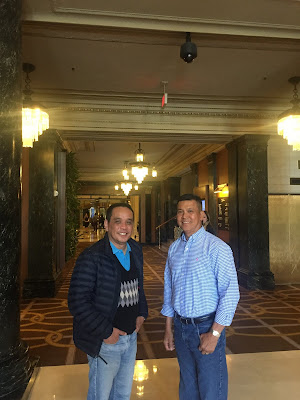 |
| The blogger with the Mighty Mite at Westin Hotel Union Square |
From previous articles in this blog
site, this blogger has professed his admiration to FEU and their basketball
products, most especially from the 70’s. When Saldaña joined forces with Lobo
and Dasalla at FEU, it didn’t take long for this writer to gravitate towards
the Tamaraws. Saldaña eventually became his favorite amateur point guard, while
cheering for his teams in the amateur ranks – first with Solid Mills, and
later, with APCOR.
This blogger went to the West Coast
last May. Because of the blogger’s association with Renato Lobo from a previous
article, the latter was able to convince Saldaña to have his profile done.
Saldaña and this blogger met at the Westin Hotel in Union Square where the
blogger was staying in his 3-day visit at the city. It was a casual moment as
Saldaña turned out to be as warm, friendly and pleasant as described by Lobo.
It wasn’t difficult to make him open up, albeit, there were some tidbits that
are best kept and not written anymore. The two spoke for more than 3 hours and
could’ve been longer had it not for prior commitments of both parties.
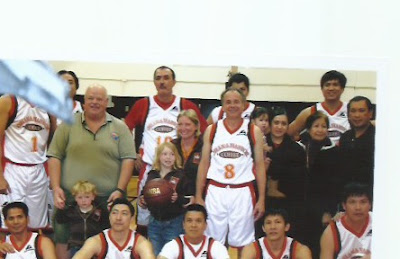 |
| Marte, seated in the middle, with other PBA legends and stars |
Saldaña’s poise and grace under
pressure was probably his greatest asset as a player. Although he’s known for a
lot of things – his cerebral quarterbacking, his adept ballhandling skills, his
pinpoint accuracy from beyond the range, Marte was clutch personified. He has
done this several times particularly for FEU, Solid Mills, APCOR and SMB. Abe
King, the franchise player of SMB in 1984, refers to Saldaña as his favorite
court general of all time. Lobo is awed by his court vision and generalship, twin
facets that not all point guards of his time possessed. Many remembered him as
a John Stockton play-alike, not flashy but gets the job done with nifty passes
and timely outside sniping.
This blogger has always been a fan
of Saldaña since his FEU days. But after the opportunity of meeting up and
knowing the Mighty Mite, he looks up to him far greater from his storied
playing career. Marte Saldaña, the unassuming and humble person that he is, has
become a larger than life person.














